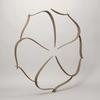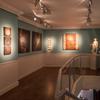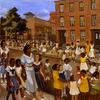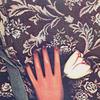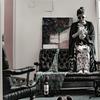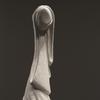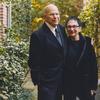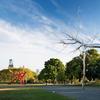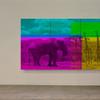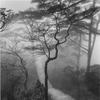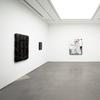Nathalia Edenmont Exhibition 'Fruitfulness' at Nancy Hoffman Gallery
- NEW YORK, New York
- /
- March 20, 2017
Swedish artist Nathalia Edenmont’s second U.S. exhibition, “Fruitfulness,” opens on March 23 and continues through May 5 at Nancy Hoffman Gallery in New York. Included are fourteen monumental photographs, portraits of women with dresses constructed of fruits and vegetables, created over the last three years. “Fruitfulness” is the first showing of these works.
Throughout art history the seasons have played a role in artists’ explorations, as has the subject of fertility and fecundity. Edenmont addresses both these themes with her unique approach and sensibility. Each of the fruits recalls a season of ripeness, a moment when nature yields a crop of tender grapes in the Fall, a bounty of green tomatoes for only two short weeks in Summer, or bright white asparagus in Spring. Without earth and worms, the harvest of fruits and vegetables would be impossible, and thus, the artist gives us a portrait of Mother Earth, a beautiful, regal woman dressed in a mountain of earth, with hair piled high and her gaze fixed on the viewer, a potent planter. To fertilize the earth, Edenmont’s self-portrait, Full of Life, has her dressed in a garment of worms, a stylish assemblage of crawling brown earth worms, while her hair is coiffed in the style of a Renaissance portrait.
Edenmont was born in Yalta, and moved to Sweden by the time she was 20, realizing that life in the Soviet Union was disintegrating and held no future for her. Sweden was a country to which she could easily get a visa, being alone in the world after the age of 14, when both her parents had died and she had no other relatives. At 27, she was accepted to Forsberg Skola, to study graphic design, where an artist mentor encouraged her to visualize her inner pictures and try to capture them with the camera. It is thanks to Per Hüttner that Nathalia is the photo-based artist she is today.
All of her work derives from her life experience. She says: “I only look inside my head. What I see in my mind is what I create. I do not sketch; the image is complete and sharp within me. I have absolute control over all aspects of what I do.” Using a large format Sinar camera with 8x10 film and many lenses, she works with a team of eight to twelve people over ten to twelve hours to compose a “shot.” She has two camera assistants, both professional photographers, a hair stylist, a dressmaker, but it is Nathalia who is at the camera, communicating, talking with the model, waiting for the perfect instant to capture the model’s soul on film. In this exhibition she adds the turning of the seasons and fertility/fecundity to her themes of time, beauty, fragility, death, transformation . Beauty surrounds the women she photographs, many of them blonde; others have Nathalia’s red tresses and are a stand-in for the artist at different ages. What each figure wears is central to the meaning of each work. The artist’s “portraits” reflect intensity; each woman is posed against a pitch-black background, robed in fruits or vegetables revealing her neck, shoulders, face and arms; light emanates from within. The dress the artist composes tells the tale. Prosperity and Fruition, both portraits of young women in dresses of grapes, one green, one red, show women in the early years of their fertility, and sensuality. The artist’s intention is clear, these are women who will be blessed with the gift of child bearing.
Nathalia says: “Since my childhood I have heard that woman’s beauty is like a flower, it passes quickly. That is why I switch from fresh flowers to dry and very old. I see much beauty in dried flowers. I grew up as a Russian Orthodox and in the cemetery the fresh graves covered in flowers looked like my flower piles from which I compose my dresses.” Her new self-portrait, Propaganda, with sprouting potatoes follows this theory. In no way does the artist look old. She is in command, looking into eternity, with hands on hips, bedecked with a queen-like potato necklace of several strands.
Since the artist’s first US solo three years ago, she has had two US museum exhibitions, along with several European museum exhibitions. Her work has been shown widely in Sweden at Alingsås Konsthall, Alingsås; Borås Konstmuseum, Borås; Dunkers Museum, Helsingborg; Galerie Leger, Malmö; Galleri Mors Mössa, Gothenburg; Galleri Stockselius, Skövde; Halmstads Konsthall, Halmstad; Konsthallen Hishult, Hishult; Kristinehamns Konstmuseum, Kristinehamn; Örnsköldsviks Museum, Örnsköldsvik; Sven-Harrys Konstmuseum, Stockholm; and Wetterling Gallery, Stockholm and Gothenburg. She has also shown at Aida Gallery, Moscow, Russia; Backfabrik, Berlin, Germany; B&D Studio Contemporanea, Milan, Italy; Galerie Forsblom, Helsinki, Finland; Galerie Hafenrichter & Flugel, Nuremberg, Germany; Galerie Terminus, Munich, Germany; Gallery Eighty, Singapore; Guy Pieters Gallery, Knokke, Belgium; l’Institut suédois á Paris, France; Park Ryu Sook Gallery, Seoul, South Korea. And in the US at Arkansas Art Center, Little Rock; and the Nordic Heritage Museum, Seattle.
She was twice a recipient of Konstnärsnämdens Arbetsstipendium, awarded by the Culture Department, Stockholm, Sweden.
Her work is included in the collections of Borås Konstmuseum, Borås, Sweden; Kristinehamns Konstmuseum, Kristinehamn, Sweden; Moderna Museet, Stockholm, Sweden; Moscow House of Photography, Moscow, Russia; Statens Konstråd (Public Art Agency Sweden), Stockholm, Sweden; Whitespace, The Mordes Collection, West Palm Beach, Florida; and 21c Museum, Louisville, Kentucky.


